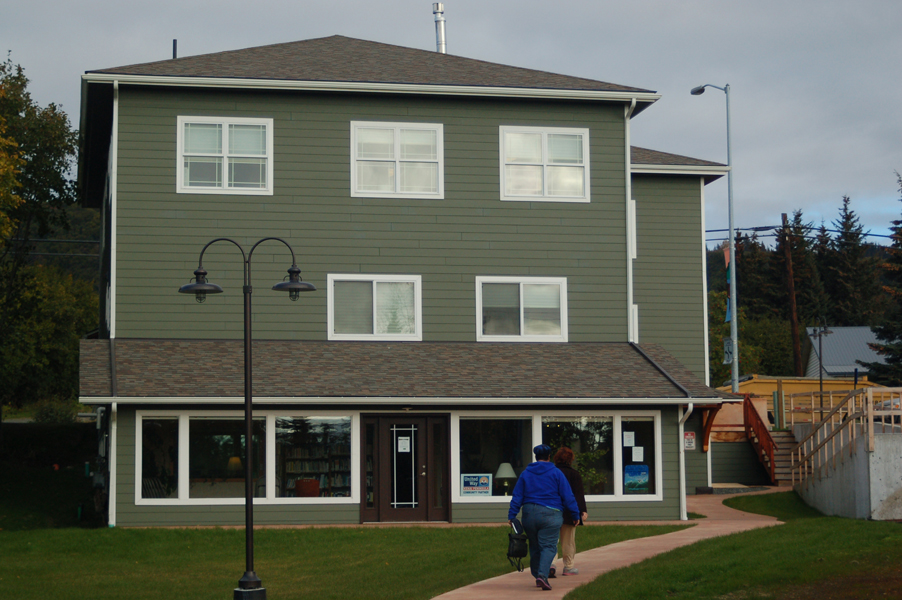The birth of Homer of Hospice started the way many lower Kenai Peninsula organizations began: Someone saw a need, jumped in and inspired others to create an organization. For Hospice of Homer, that person is Jean Hatfield, who founded the organization in September 1985.
Now in its 29th year, Hospice of Homer holds an open house 5 to 7 p.m. Wednesday at its new offices on Pioneer Avenue in the lower level of the historic Pioneer Hardware building next to Captain’s Coffee.
Hatfield started Hospice of Homer after she saw how well hospice worked with her mother-in-law in Bethesda, Md. Eileen Callis-Sterling had breast cancer and went home to hospice care. She had not been expected to live long, but lived another five weeks in her own home and surrounded by plants, music, family and friends.
“I kept thinking, ‘There’s got to be something to this hospice.’ She lived so much longer than anybody expected,” Hatfield said.
Hatfield also started hospice for the help it gave her family, like how to deal with someone dying and what to do.
“Just the support they provided us,” Hatfield said. “They relieved us. A lot of it was answering the questions.”
The modern hospice movement started with Dame Cicely Saunders, who began working with the terminally ill in 1948 and later started the first residential hospice in a London suburb. Saunders brought the idea of hospice to the United States during a 1963 visit to Yale University, New Haven, Conn.
Hatfield started Hospice of Homer when she put out a call to the community and they met in her mother, Winnie Hatfield’s, living room.
“We got together and formed a board. We each donated $20. I got a post office box,” she said. “It was very homegrown.”
Winnie Hatfield was vice-president and answered phones. Marilyn Dugdale was the first president.
“It was a very loose organization when we started,” Dugdale said. “If you do this, I’ll do that.”
Hospice had its first office in a back room at what’s now the Refuge Chapel building on Pioneer Avenue. Hospice also was at a Bartlett Street office next to the Independent Living Center. It’s now back in a new building with the ILC.
One program that’s been with Hospice of Homer from the start is its medical equipment loan program, where people can borrow equipment like hospital beds or walkers. Like all Hospice of Homer programs, equipment loans are free. Hatfield remembered a neighbor of her mom borrowed a bed, and when they got it back, the neighbor donated $50.
“From there the equipment loan program was born,” Hatfield said.
Dugdale remembered when a bed got stored in the living room of her trailer because she was the only one who had space. Before Hospice of Homer moved into its new offices, it had equipment scattered around town in four or five storages spaces.
Now, most of the equipment is in a back room of its offices, with a cleaning and maintenance area. Clients don’t have to be hospice patients, either. People needing temporary loans, like family visiting for the summer, can borrow equipment.
That’s the other unique thing about hospice, Hatfield and Dugdale pointed out: while end-of-life care is its focus, Hospice of Homer also serves many kinds of clients. Equipment loans can go to anyone needed things like beds. Hospice volunteers visit the dying, but also the elderly and homebound.
“This hospice fits the community,” Dugdale said. “It might not work anyplace else, but for Homer it fits. It works.”
One time Hatfield checked with the National Hospice and Palliative Organization to see if Homer Hospice was heading in the right direction. The president called back and said he would be in Homer for a honeymoon and could visit them, which he did.
“He basically said, ‘You guys are doing great. You’re on the right track and just keep doing it,’” Hatfield said.
That’s the other remarkable thing about Hospice of Homer, too, Hatfield said. Homer has embraced the organization.
“What’s so important is the support Homer has given hospice from the beginning,” she said. “
“That’s the amazing thing to me and to Jean about hospice,” Dugdale said. “This community has been so supportive over the years.”
“We’re just a striving organization, as you can see with that new office,” Hatfield said “It’s a long way from my mother’s living room.”
Michael Armstrong can be reached at michael.armstrong@homernews.com.
Hospice of Homer
Location:
265 Pioneer Ave., Suite 3
235-6899
www.hospiceofhomer.org
founded:
September 1985 by Jean Hatfield
Open house:
5-7 p.m. Wednesday
wheelchair accessible, except trail is rough at the lower end.
Services offered:
End of life: Respite services, minor home maintenance, transportation, emotional support, errands
Volunteer visitors and phone friends: visit, phone calls, lawn work, cleaning, reading
Bereavement: support groups, grief counseling, lending library, remembrance events
Equipment loans: Hospital beds, wheel chairs, walkers, canes and crutches, bed cushions, toiler rises, bed pans, shower benches, lift chairs


